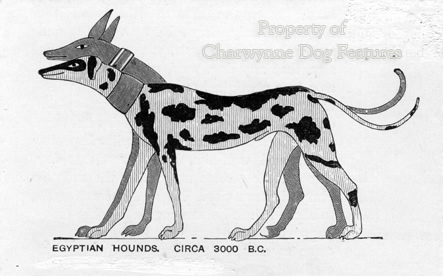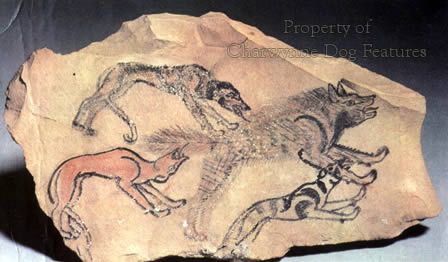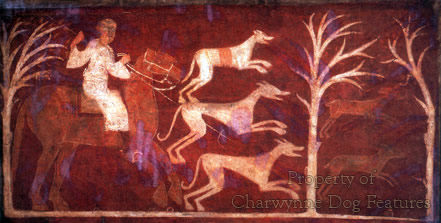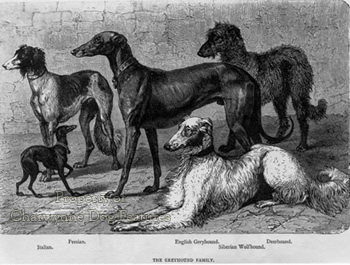228 THE COURSING DOGS
THE COURSING DOGS
by David Hancock
 Ancient History
Ancient History
Much is made by breed-historians of the hounds of Egypt, Greece and Rome but there is ample evidence of hound-like dogs long before these times. In the mesolithic period, 9000 years ago, one or two species of larger animal provided the main source of meat in the human diet. In Europe these were red deer and wild boar, in North America the bison and in western Asia the gazelle and wild goat. One survey (Jarman 1972) carried out in 165 sites of late palaeolithic and mesolithic age throughout Europe revealed the meat-sources of the hunter-gatherers. 95% of the sites indicated the presence of red deer, 60% showed roe deer, 10% revealed elk and chamois and a few had bison and reindeer. 20% of the sites indicated the presence of dog.
Early Records
One of the earliest records of dog remains comes from the palaeolithic cave of Palegawra in what is now Iraq, some 12,000 years old. Canid remains found at Vlasac in Romania date from c.5400-4600BC and the other remains there indicate no other domesticated animals. There were huge hefty hunting dogs throughout western Asia from well before 2000BC and a variety of hunting dogs in ancient Egypt, their white antelope dog resembling our modern harriers in conformation. The Celts, the Greeks and the Romans greatly prized their hunting dogs and left descriptions of them. Hounds were extremely valuable as pot-fillers and were therefore extensively traded. But well before 2000BC, the Sage Kings of the Yellow River valley in China, the Dravidians of the Indus valley in India and the Sumerians in the valleys of the Tigris and the Euphrates were, especially by European standards of that time, sophisticated hunters. Discoveries from near Ergani in Turkey dated from 9500BC and from east Idaho in the United States dated from 9500BC to 9000BC prove the existence of tracking dogs in cave settlements. Ivory carvings from Thebes, dating from 4400 to 4000BC, depict fast running hounds. The Phoenicians had hounds hunting both by speed and by stamina using scent. In Babylon powerful short-faced hounds were used to hunt wild asses and lions. The Assyrian kings, assisted by their keepers of hounds, hunted lions, wild bull and elephant. From 2500BC onwards hunting with hounds was a favourite entertainment for noblemen in the Nile delta.
Development of Breeds
One scribe of the 19th dynasty described a pack of hounds, 200 of one type, 400 of another, stating that "The red-tailed dog goes at night into the stalls of the hills. He is better than the long-faced dog, and he makes no delay in hunting..." In the Rig-Veda, an ancient Sanscrit record of Hindu mythology, we can find hound-like dogs described as "broad of nostril and insatiable..." In time the specialist hounds developed physically to suit their function, the "long-faced" dogs needing a slashing capability in their jaws backed by excellent longsighted vision, to become, in time, our sighthounds. The "broad-nostrilled" wider-skulled looser-lipped dogs needed plenty of room for scenting capacity in both nose and lips where scent was tasted, to become, in time, our scenthounds. As hounds became linked with human preferences in method of hunting and choice of quarry, so the breeds developed.
Greyhound-like Dogs
It is possible to find in Greek and Latin literature some sixty-five breed-types by name although some are merely synonyms. The Greeks had hound breeders who insisted on the importance of pure bloodlines. But not all their hounds were Greek in origin for the Greeks were a maritime people, with knowledge of the whole of the Mediterranean and the Black Sea. Pollux and Oppian refered to a breed coming from the Spanish peninsula as the Iberian; in Italy there was the Ausonian, discovered by Greeks settling in Naples, the Salentine, the Tuscan (a hunting dog which indicated concealed game not a ground scent seeking hound) and the Umbrian, able to run down game but not kill it. Flavius Arrianus, in the second century A.D., described two Celtic breeds, the Segusiae (named after a tribe from a province which included what is now Lyons) with excellent noses, good cry but a tendency to dwell on the scent and the Vertragi (literally "lots of foot"), rough-haired greyhound-like dogs.
Medieval Hunting
As described in the Preface, the sighthound type was widely used in the medieval hunt. Terms used then were often loosely applied, with perhaps the best explanation being in the Appendix to the Baillie-Grohmans’ editing of The Master of Game, the Duke of York’s translation of Gaston de Foix’s Livre de Chasse of 1387. Hunting mastiffs were alauntes; brachets or bercelets were hunting dogs that accompanied those who shot their game, rather like the Bavarian Mountain Hounds of today, with their valued tracking skills (but could also mean small bitch hounds); lymers were leashed scenthounds, used rather as ‘tufters’ are used in the staghound packs; raches were the smaller mainly white packhounds rather like the once-famous Curre pack here (but could also mean bitch hounds); bandogges were the ferocious ‘seizers’, slipped at the kill, to save the more valued running hounds; greyhounds were the Grehounds or levriers, not the modern breed of Greyhound, with the fierce and shaggy Irish and Scottish deerhound called the ‘levrier d’attache’ or ‘held-dog’ and the smaller smooth-coated hound, the ‘petit levrier pour lievre’ or small hare-hound. A brace, or more usually three, was handled by a fewterer. Heyrers were the tricolour Harriers of today; gazehounds were used in packs ‘at force’.
Central European Terms
In his exhaustive Lexicon of the Medieval German Hunt, De Gruyter & Co., Berlin, 1965, David Dalby lists the various terms for hunting dogs used then. The word wint was used to denote both the purpose-bred Greyhound and the heavier veltre or zwic-darm, which was a blend of Mastiff and Greyhound, resembling the bull lurchers of today. The habech-wint or beiz-wint was the Greyhound used with the hawk. The Greyhound was also called wint-spil, and hasen-wint when used to course hares. It is clear from the long list of sources referred to by Dalby that coursing in medieval Germany and the surrounding small states was carried on at a vast scale and it’s surprising that a German sighthound didn’t emerge and survive, but the Germans do not have a good record at conserving their old hound breeds. There is reference in the German hunt to the wind-bracke, which could be translated as the hound that hunts by speed and scent, perhaps their gazehound.
Different Function of Gazehound
In his Of English Dogs published in 1576, Dr Caius mentions the gazehound and the Greyhound quite separately, clearly not considering the latter to be a type of the former. Nowadays, wrongly, we blur the gazehound and the sighthound, regarding the two words as synonyms. Caius writes “Our countrymen call this dogge a Gasehounde because the beames of his sight are so stedfastly settled and unmoveably fastened.” Caius uses the word Greyhound for ‘another kinde of Dogge’- as a general term for hounds that hunt using speed, not for a distinct breed, mentioning their ‘incredible swiftness’ and their ‘principal service in starting and hunting the hare’. He went on to describe them with phrases such as ‘For it is a spare and bare kind of dog (of flesh, but not of bone): some are of a greater sort and some lesser; some are smooth skinned, and some are curled. The bigger therefore are appointed to hunt the bigger beasts, and the smaller serve to hunt the smaller accordingly.’ That is a fair summary of the sighthound group and certainly no word picture of just today’s recognised breed of Greyhound.
Par Force Hounds
Dr Caius also wrote on gazehounds: "Horsemen use them more than footmen, in the intent that they might provoke their horses to a swift gallop...and that they might accustom their horse to leap over hedges and ditches, without stop or stumble..." He described their modus operandi as that of ‘never ceaseth until he hath wearied the beast to death.’ Both these quotes hardly represent an account of a sighthound at work. It is a good description of par force hunting, in which medieval huntsmen rode hard, rather as in steeplechasing, after hounds which hunted by sight and scent. Bewick in his History of Quadrupeds of 1790 drew on Caius's words, listing the gazehound, (stating it was ‘somewhat similar to the Greyhound’), as well as, quite separately, distinct types like the Greyhound, the Highland Greyhound and the Irish Greyhound. The English poet, Thomas Tickel (1686-1740), in his A Fragment on Hunting Dogs, mentions the gazehound (‘how with glance severe from the close herd he marks the destined deer’) and, quite separately too, the Greyhound for the hare.
17th Century Differentiation
In his The Gentleman’s Recreations of 1674, Nicholas Cox mentions the eleven breeds of hound of that time. He describes the gazehound as being “used for catching the fox and hare, hunting chiefly by sight in open country, employed by people riding”…“popular in the north of England” but adding later a reference to the gazehound as “our little beagle with swift foot and ready voice”. He then describes the Greyhound, quite separately, as being still of gra-hound type, not so big as the wolf-dog in Ireland, being used for coursing. He clearly considered the Greyhound and the gazehound as being wholly different hounds.
Wider use of word Greyhound
The Sportsman’s Cabinet of 1803 continues the use of the word Greyhound as a substitute for sighthound rather than as a breed title but errs in stating ‘it being evidently demonstrable, that gazehound was the original appellation in applicable allusion to that particular kind of dog running by sight and not by scent.’ The editor of this valuable tome had clearly not read Caius’s words of nearly three centuries before his rather tortuous words over-confidently stated his case. In his valuable book The Dog in Health and Disease of 1867, the celebrated ‘Stonehenge’ records: "THE GAZEHOUND - This breed is now lost, and it is very difficult to ascertain in what respects it differed from the greyhound." I don't believe the great man got that right. It is not justifiable to refer to this type as a breed; the word Greyhound has long been utilized to cover any hound with the sighthound function. In his authoritative Hounds in Old Days of 1913, Sir Walter Gilbey, who knew his hounds, wrote of the gazehound, extending the words of Dr Caius: “This was not the greyhound – which is concisely summed up as a ‘spare and bare kind of dog’ – and the statement that the ‘gazehound’ hunted by sight, depending little or not all on its nose, forbids the assumption that Caius refers to the Northern Hound or Northern Beagle; which, as Gervaise Markham shows, had a very good nose.” The gazehound may well have been an ancestor of types like the Fell Hound, which tracks its quarry using scent and then pursues it at pace or par force.
Old Meaning of ‘Gaze’
Par force hunting fell out of favour in Britain, especially in the south, the slower 'hunting cunning', using scenthounds, replacing it. But boarhounds and staghounds across mainland Europe were employed in this style of hard-pursuit quarry-hunting for much longer. In otter hunting to 'gaze' meant to view the otter. Shakespeare wrote of "...the poor frighted deer, that stands at gaze..." The word 'gaze' clearly had a more precise meaning than merely 'see' or 'sight'; it has a Scandinavian origin and meant to fix one's eye on an object. Par force hounds located their prey by using scent and, once they caught sight of it, fixed their eye on it and went, often with reckless speed, wearying the beast to death, as Caius recorded. Sighthounds don’t hunt in packs ‘at force’; they hunt at speed, sometimes as a brace, but using athleticism, agility, inherited skill, recalled experience, immense stamina over hundreds of yards, maintaining astonishing pace and applying great determination. It is belittling to blur them with the gazehounds that have quite different skills and need a different anatomy to succeed in the hunting field. Researching a gazehound in historical references having assumed the word refers to a sighthound is not wise. Regarding historic references to ‘Greyhounds’ as referring only to the breed of that name can be just as misleading.
The Eternal Sighthound Physique
The sprinters of the canine world have become known, in modern times, as sighthounds, although they hunt by speed, using sight mainly, but scent too. The need for their extreme pace has bestowed upon them a distinctive anatomy, right across the breeds, and with it a physical stylishness and a natural elegance that makes them the aristocrats of the dog world. They rely on long legs, deep chests, lightness of build, strong feet and keen eyesight. Their detection of movement, often at great distances is astonishing. In silhouette, size and coat texture apart, the various sighthound breeds resemble each other, function deciding form. A big Whippet can be mistaken for a small Greyhound; a smooth Saluki can be confused with a Sloughi; both the Spanish Galgo and the Hungarian Magyar Agar can be taken for Greyhounds and the bat-eared breeds of the Mediterranean littoral are easily misidentified. They look similar because their function is similar; no sighthound can function with anything other than a sighthound physique. Hounds that hunt using their stamina, and rely mainly on scent to pursue their quarry are governed by very different design criteria.
Sighthound is Modern Word
In his The Kennel Encyclopaedia of 1908, J Sidney Turner writes under the heading of the Eastern Greyhound: “Before discussing the various breeds of Greyhounds, it may be of interest to note the various names by which they are called. The term Tazi Kutha, or running dog, is a Persian word, now indiscriminately applied by natives of India and Persia to all breeds of Greyhounds be they English or Eastern.” If he were writing today, he would use the word sighthound instead of the word Greyhound. In this four volume encyclopaedia he does not list the word sighthound at all. In his valuable but strangely under-rated two volume The Dog Book (Heinemann, 1906) the extremely knowledgeable Scottish writer James Watson records on the Greyhound: “There is no doubt that the name was made to cover a great many dogs that were not what we call greyhounds. It is not so long ago that deerhounds and wolfhounds were called Scottish and Irish greyhounds. The Russian wolfhound was mentioned as the Russian greyhound and his close relative of Persia had also the same breed name and if we go further back we cannot find traces of dogs that must have existed in England and could only have been included in the general group of greyhounds.” He did not use the generic term sighthound in his 800 page masterpiece. Need to Sub-divide Hound Breeds
Another expert of those times, Robert Leighton, in his comprehensive The New Book of the Dog of 1912 (Cassell), a 650 page tome, covers the ‘sprinter’ breeds extensively but without using the word sighthound. He has 10 pages on Oriental Greyhounds too. Nearly a century later, we have Juliette Cunliffe in her Sighthounds, Their History, Management and Care (Swan Hill, 2006) opening with: “The group classified as Sight Hounds can just as easily be called Gaze Hounds or, indeed, from the natural history point of view, the Greyhound group.” I don’t think Dr Caius would support that opening sentence and he lived in times when gazehounds and Greyhounds co-existed! In his authoritative A History of Domesticated Animals (Hutchinson, 1963) Frederick Zeuner writes extensively on the early history of the dog but writes of the greyhound type not the sighthound type. He didn’t need of course to collect breeds into groups for show purposes and perhaps kennel clubs in the pedigree dog world found a need to divide the speedsters from the scenthounds and chose the group name sighthounds; that is useful but should never be taken to mean that the speedsters only hunt using their eyes, because they don’t. Less sophisticated sportsmen in East Anglia called their lurchers ‘look-dogs’, knowing they mainly relied on their eyes when hunting.
Common Purpose
The various breeds of sighthound can sound, from their breed names, designed for a specific task – as the titles Wolfhound and Deerhound exemplify, very exotic – as the name tags Saluki, Azawakh and Cirneco dell’Etna illustrate or simply down to earth – as breed names such as Whippet, Rabbit Dog and Caravan Hound indicate. But whether sounding specialist, exotic or mundane, they all have the same purpose, catching their quarry using speed, sight, agility and sheer athleticism. Their owners varied from the highest in the land, with their elaborate hunting pageantry, to the lowly peasant or nomad hunter, relying on a skilful hound to feed his family. They were admired for their grace, physical beauty and stylish charm, but valued for their hunting prowess. No hungry man gives food to a useless dog.
Conservation Need
Sighthounds are found all over the world and in some unexpected places. In Admiral Anson’s report on his historic circumnavigation of the globe in 1740-4, there is mention of Goat Island off the coast of Chile where “The place is covered with dogs of an enormous size resembling the greyhounds.” Wherever any sighthound breed comes from and whatever its coat length, we should respect their heritage, perpetuate them as honourably as Bedouins do and "control" their breeding just as strictly as the latter do. Is any sighthound not physically constructed for hunting really a sighthound at all? This book argues for real sighthounds to be conserved both in their anatomical and their spiritual content; they are a precious feature of our canine coverage. We really must find alternative sports for them, simulating the chase and testing their ancient long-treasured talents.
“Coursing Dogs – These were generally smooth, short-haired animals with slender bodies set on long legs, pointed heads, either small pointed or larger floppy ears and a long thin tail. It is one of the most frequently represented of all the breeds and clearly held a position of some esteem both as a valuable hunting hound and as a companion of the gods. The earliest representation is of a Saluki-like hound on a leash appearing on pottery from the Halaf period (5300-4300 BC). A seal impression in sun-dried clay from the Chalcolithic period c.5000BC at Tell Arpachiya in Mosul reveals ‘some kind of coursing dog, perhaps a greyhound.’”
Dogs in Antiquity, Anubis to Cerberus by Brewer, Clark & Phillips, 2001, Aris & Phillips.